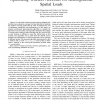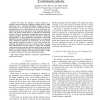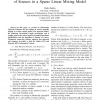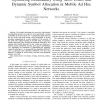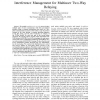CISS
2008
IEEE
14 years 6 months ago
2008
IEEE
—The results of 2 experiments in Costas arrays are presented, for which theoretical explanation is still not available: the number of dots on the main diagonal of exponential Wel...
CISS
2008
IEEE
14 years 6 months ago
2008
IEEE
—Large-scale wireless networks must be designed such that there are no gaps in coverage. It is also desirable to minimize the number of access points used in order to minimize th...
CISS
2008
IEEE
14 years 6 months ago
2008
IEEE
— We study the problem of relay selection in a wireless cooperative network. Assuming a single source, a single destination, and N uniformly distributed candidate relays, we seek...
CISS
2008
IEEE
14 years 6 months ago
2008
IEEE
—In this paper we present an Information Theoretic Estimator for the number of sources mutually disjoint in a linear mixing model. The approach follows the Minimum Description Le...
CISS
2008
IEEE
14 years 6 months ago
2008
IEEE
—We consider the design of a network in which packet transmissions between two nodes are to be guaranteed a certain probability of success. There are N independent paths between ...
CISS
2008
IEEE
14 years 6 months ago
2008
IEEE
—In a conventional wireless cellular system, signal processing is performed on a per-cell basis; out-of-cell interference is treated as background noise. This paper considers the...
CISS
2008
IEEE
14 years 6 months ago
2008
IEEE
—We consider a multiuser two-way relay network where multiple pairs of users communicate with their pre-assigned partners, using a common intermediate relay node, in a twophase c...
CISS
2008
IEEE
14 years 6 months ago
2008
IEEE
—Magnetic resonance imaging (MRI) may be viewed as a two-stage experiment that yields a non-invasive spatial mapping of hydrogen nuclei in living subjects. Nuclear spins within a...
CISS
2008
IEEE
14 years 6 months ago
2008
IEEE
— In this paper, we investigate resource allocation for a multi-user OFDMA cooperative system. Aiming at minimizing the total transmission power under target rate constraints for...
CISS
2008
IEEE
14 years 6 months ago
2008
IEEE
—Permutations of order N are generated using polynomials in a Galois field GF(q) where q > N+1, which can be written as a linear transformation on a vector of polynomial coeff...

